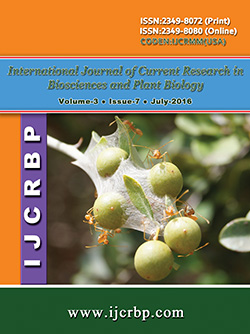 |
Online ISSN : 2349-8080 Issues : 12 per year Publisher : Excellent Publishers Email : editorinchiefijcrbp@gmail.com |
2Sri Jayadev College of Education and Technology, Naharkanta, Bhubaneswar-752101, Odisha, India
The present investigation was carried out to compare the effect of vermicompost prepared from lead phytoremediated aquatic weeds and naturally reared aquatic weeds on the growth and yield of green gram [Vigna radiata (L.) Wilczek] under potted conditions in the Botanical garden of Utkal University. Vermicompost was prepared from cow-dung and aquatic weeds namely Azolla microphylla, Pistia stratiotes, Salvinia cucullata and Salvinia molesta by using earthworms (Perionyx excavatus). The pot experiment was conducted with nine treatments each having three replicates i.e. control (C), Azolla vermicompost (AV), treated Azolla vermicompost (TAV), Pistia vermicompost (PV), treated Pistia vermicompost (TPV), Salvinia cucullata vermicompost (S.cuV), treated Salvinia cucullata vermicompost (TS.cuV), Salvinia molesta vermicompost (S.mV), treated Salvinia molesta vermicompost (TS.mV).The test aquatic plants were used for phytoremediation with 50 ppm Pb (NO3)2 solution. The results of the present experiment indicated a significant variation in plant growth and yield of green gram, physico-chemical properties and heavy metal (Pb) content of different vermicompost samples. The Pb concentration in the vermicompost samples were found within the permissible limit i.e. below 100 mg/kg. The highest bioaccumulation of Pb was observed in treated Azolla-vermicompost sample (98.9mg/kg) and lowest in non-treated Pistia-vermicompost (8.10mg/kg). The significant variation in the growth parameters of the test crop such as plant height, number of shoots and root branches, number of leaves and flowers per plant, number of pods per plant, pod length as well as number of root nodules per plant were recorded on 15th day, 30th day, 45th day and 60th day of sowing seeds. The maximum value of growth parameters was claimed when grown with amendments of AV followed by PV and SV. Compared to other treatments, Azolla vemicomposting (AV) was proved to be the best one for the test crop under study. Analysis of biochemical properties of the prepared vermicomposts revealed that they can play a major role in the growth and development of green gram. The present investigation also confirmed the process of conversion of phytoremediated aquatic weed biomass into vermicompost thereby indicating their ability for an ecofriendly technology in sustainable agriculture. The study also revealed the way for management of the rapid growth of aquatic weeds by utilizing them for bioremediation as well as the production of vermicomposts
